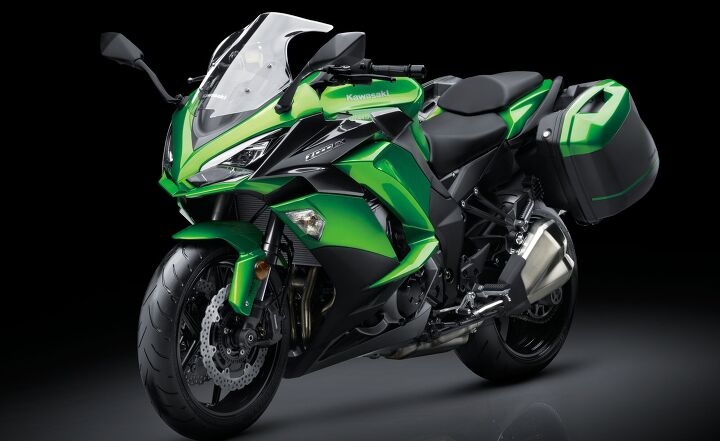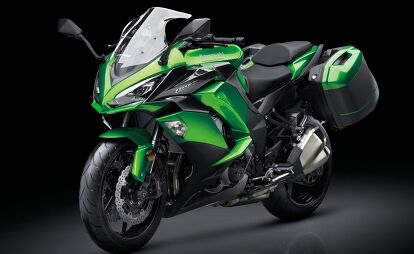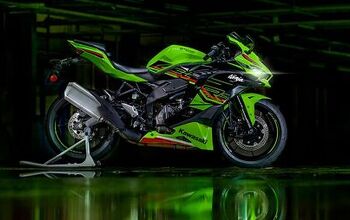2017 Kawasaki Ninja 1000 Preview

Six-axis IMU and revised touring amenities highlight 2017 Ninja 1000
At Intermot 2016, Kawasaki announced the Ninja 1000 sport tourer would receive a host of upgrades to enhance both the sport and touring sides of its dual personalities. While there are obvious design changes to make the bodywork fresh, chief among those updates is the addition of a six-axis IMU from Bosch. With it, the 2017 Ninja 1000 electronics suite is now able to offer much more sophisticated levels of control. Both the Kawasaki Traction Control (KTRC) and Kawasaki Intelligent anti-lock Brake System (KIBS) utilize the IMU to get a real time picture of the motorcycle’s chassis orientation, which it can then use to intervene if needed, and the level at which intervention is applied.
Specifically, the IMU enables the KTRC system to offer more precise wheelie control, while KIBS now offers rear lift mitigation and minimal lever kickback during operation. The ECU also takes into account feedback from the IMU, throttle position sensor, clutch actuation, and gear position to account for back torque while using the rear brake and downshifting.
Maybe the biggest benefit of the IMU, though, is the ability to offer what Kawasaki calls corner braking control, a.k.a. lean-angle sensitive ABS. Says Kawasaki, “Should riders use the brakes beyond the entrance to a turn (i.e. trail braking) or mid-corner (e.g. to avoid an obstacle), brake force is modulated to counter the tendency of the bike to stand up under braking. This assists riders in tracing their intended line through the corner instead of running wide.”
Other changes include revised ECU settings for smoother power delivery and exhaust canister revisions to meet Euro 4 regulations (though those changes don’t apply to U.S.-bound Ninja 1000s).
On the chassis side, there’s a revised shock linkage Kawasaki says offers suppler suspension action while also lowering seat height slightly from 32.3 inches to 32.1 inches. Rear brake pad material has also been revised.
The list of touring-oriented updates for the Ninja 1000 is impressive as well, with a new double-bubble windscreen that’s 15mm taller in the center than before. It’s still adjustable to three different positions, without tools, to suit rider preference. The two-piece fairings are 28mm wider on each side to deflect more wind from the rider’s legs and cover a portion of the frame to help keep engine heat away.
Headlights are now brighter and cast their light farther forward, using LED bulbs that draw 50% less power. In accordance with Euro 4 regulations, an LED position light has also been added.
From the ergonomic side, the updated Ninja 1000 gets a five-way adjustable clutch lever and mirrors that are spaced 20mm farther outward, with a greater range of movement. The rider’s seat is broader, while the passenger seat is longer and features thicker padding for more comfort. The pillion seat’s shape is also bulged at the front to help prevent the passenger from sliding forward into the rider.
The redesigned tail section of the Ninja 1000 sees the passenger grab handles separated from the pannier mounting location, so now the clean-mount luggage can simply slide into their slots without the need for an accessory passenger grab handle like on the current model.
Lastly, a new instrument panel is dominated by a large analog tachometer, but is now joined by a gear position indicator and programmable shift lights.
Among the Ninja 1000’s accessories, a few things stand out. They are:
- A larger GIVI top case (12.4 gallons, 11 lbs max) offers enough room to hold two full-face helmets. Like the panniers, the top case can be fit with the one-key system.
- ERGO-FIT low-seat reduces the seat height 8 mm, facilitating the reach to the ground for increased confidence and comfort. Seat leather is the same cold-resistant, high-elasticity-type material used on the standard seats.
- Other available accessories include: smoked windshield, gel seat, single seat cover, tank bag, smart bag (JPN only), soft top case, grip heaters, DC outlet (7.5 A, 20 W), GPS unit bracket, sliders, crankcase rings, front axle sliders, tank pad, knee pads, wheel rim tape.
- All of the accessories are bolt-on.

Troy's been riding motorcycles and writing about them since 2006, getting his start at Rider Magazine. From there, he moved to Sport Rider Magazine before finally landing at Motorcycle.com in 2011. A lifelong gearhead who didn't fully immerse himself in motorcycles until his teenage years, Troy's interests have always been in technology, performance, and going fast. Naturally, racing was the perfect avenue to combine all three. Troy has been racing nearly as long as he's been riding and has competed at the AMA national level. He's also won multiple club races throughout the country, culminating in a Utah Sport Bike Association championship in 2011. He has been invited as a guest instructor for the Yamaha Champions Riding School, and when he's not out riding, he's either wrenching on bikes or watching MotoGP.
More by Troy Siahaan


























































































Comments
Join the conversation
I'd look for a year old holdover fjr first.
Almost 40k miles on my 2014. Fantastic bike, zero drama. Did have to upgrade shock, but this bike runs rings around the competition.
https://uploads.disquscdn.c... https://uploads.disquscdn.c...